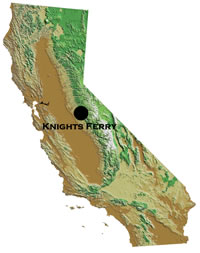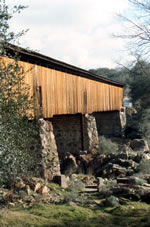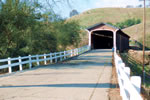Covered Bridges of the Sierra Nevada Region
Sprinkled throughout the Sierra Nevada and foothills are a number of covered bridges – two are the best-known and most accessible.
Knights Ferry, Stanislaus County
 About twenty miles west of Sonora and literally a hop-and-skip over the conjunction of Stanislaus and Tuolumne Counties lies Knight’s Ferry—an historical jewel in the crown of Stanislaus County.
About twenty miles west of Sonora and literally a hop-and-skip over the conjunction of Stanislaus and Tuolumne Counties lies Knight’s Ferry—an historical jewel in the crown of Stanislaus County.
In 1849, William Knight set up shop at this location. Knight established a trading post and ferry service. Knight had come from Yolo County, where, in 1843, he had established the still standing town of Knight’s Landing.
Knight’s ferry service prospered almost immediately. Soon cargo, both human and commercial, was utilizing the service across the tumbling Stanislaus River.
The site was ideally suited for the purpose and the profits were significant. Daily revenues of $500 were not unusual. Along with partner James Vantine, Knight was doing well.
Unfortunately, Knight would not live long and prosper. On November 9, 1849, Knight was killed on the streets of the town he had founded. Vantine continued on with new partners, John and Lewis Dent. Vantine and the Dents expanded the business to include a restaurant and boarding house.
It might have been Dentville
In 1851, the town applied for a post office. The Brothers Dent tried in vain to get the town renamed Dentville, but Knight’s Ferry stuck.
The Dents planned to build a bridge across the river. They purchased the lumber. They may have had their brother-in-law, Ulysses S. Grant, draw up the plans. Grant had married the Dent’s sister Julia. Grant was serving in California and was visiting the brothers in 1854.
But … the Dents never got around to it. Instead they sold the business to David Locke in 1856. He would build the first bridge.
The County Seat for a decade
The town boomed upon the bridge’s completion. Knight’s Ferry would boast two hotels, for general stores, two attorneys, livery stables, a blacksmith, and much more. In 1860, the town became part of Stanislaus County when the map was redrawn. From 1862 to 1872, Knight’s Ferry was the County Seat of Stanislaus County.
Everything looked rosy. Then toward the end of 1861, heavy rains swept across the area, melting the massive snowbanks upstream. On January 11,1862, the river crested at Knight’s Ferry — more than thirty feet above its normal level. The torrent rushed through town destroying everything in its path. It looked as if the bridge would survive the flood, until … the bridge at Two Mile Bar, just upstream from Knight’s Ferry, broke loose and smashed into the Knight’s Ferry bridge. The bridge became rubble.
The old ferry service was brought back into service as decisions were made about building a new bridge.
The new bridge was now covered
Locke rebuilt quickly. By March 1862, construction on a new bridge had begun. By Spring 1863, it was completed. The 355-foot bridge was now covered and stood eight feet higher than the old bridge.
Although the covered bridge was a private concern, the tolls were set by the County Board of Supervisors. The tolls range from two cents upward. Interestingly, the tolls include fees for camels and elephants — two dollars for a camel, and three dollars for a pachyderm.
In 1868, Locke sold to Thomas Edwards, who continued to operate the toll bridge for years, albeit at lower profits. Today the bridge is part of the Stanislaus River Parks, operated by the United States Army Corps of Engineers.
The park is about more than the bridge
The park headquarters are located in Knight’s Ferry. The Information Center provides information on the salmon life cycles and Native American cultures as well as displays related to the Covered Bridge and the remaining structures of the old town. Most notable among these ruins is the Locke Grist Mill.
Closed to vehicular traffic in 1981, the bridge is open to foot traffic only. Fully restored by the Corps of Engineers in the years since it was closed to cars, the Knight’s Ferry Covered Bridge is the longest in California, the ninth longest in the United States, and the longest “authentic” (meaning “historic”) covered bridge west of the Mississippi.





